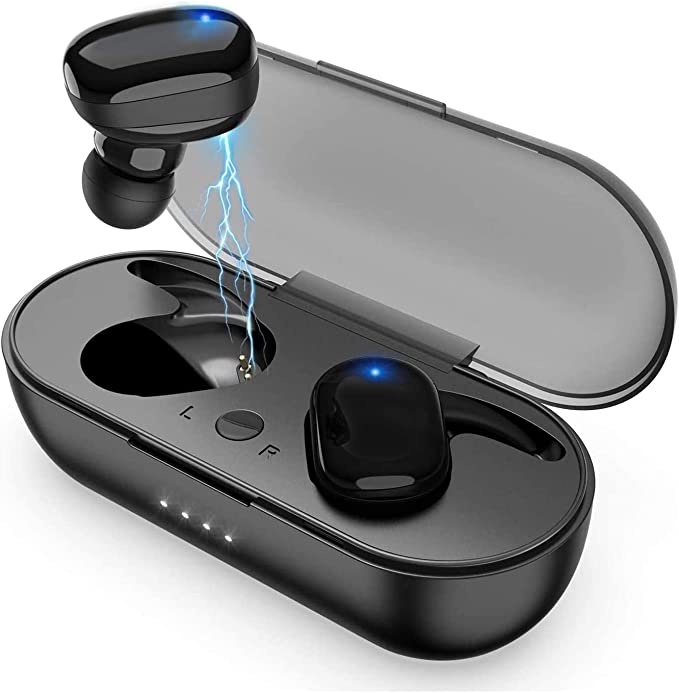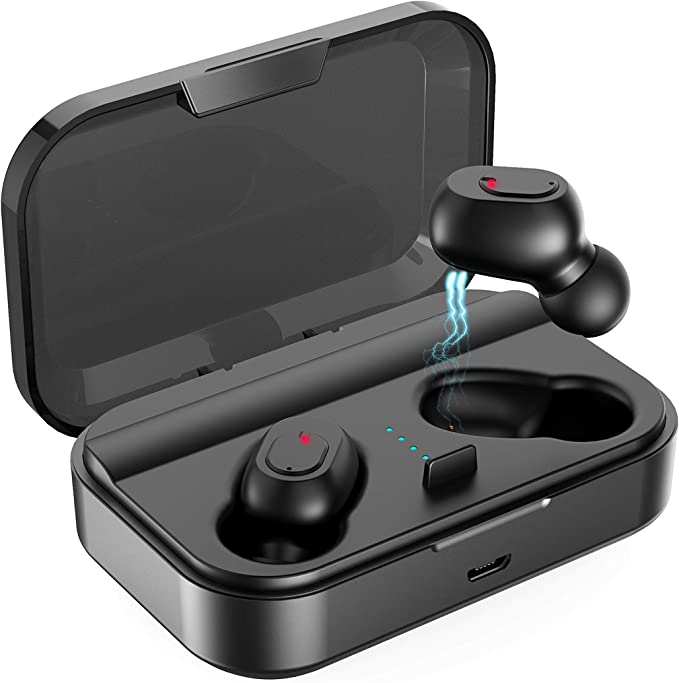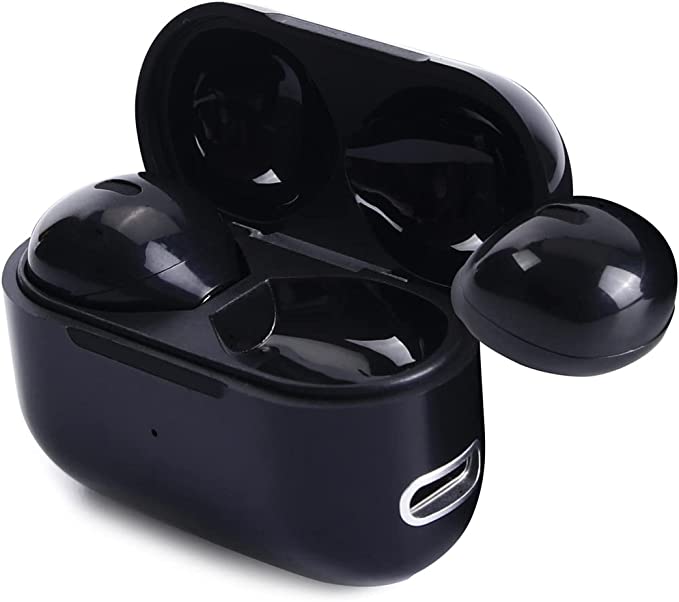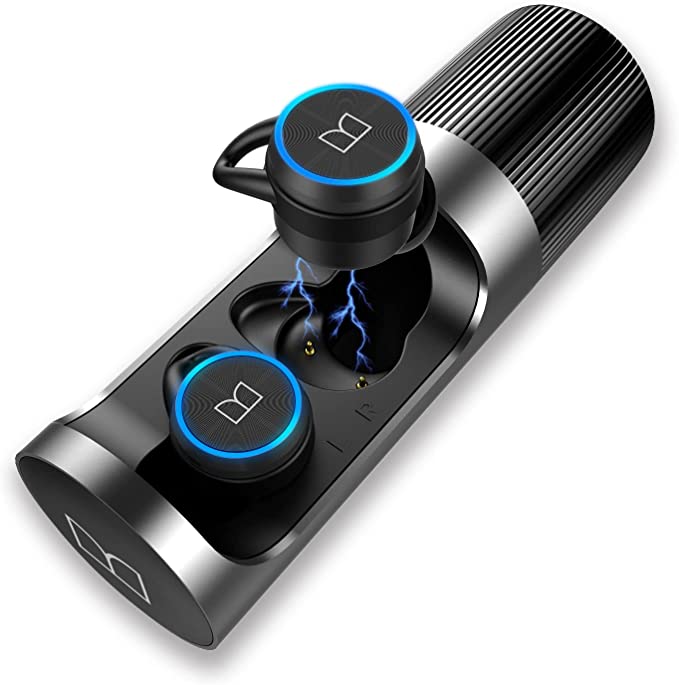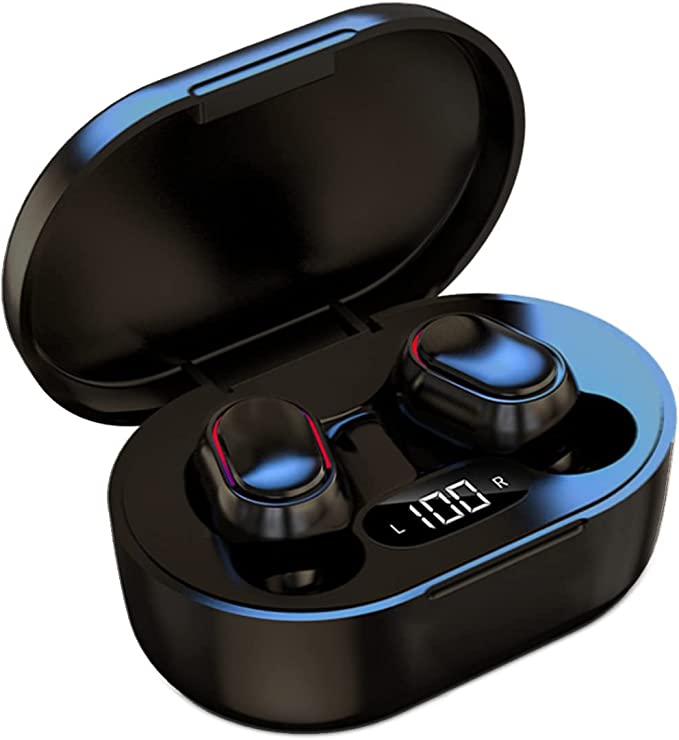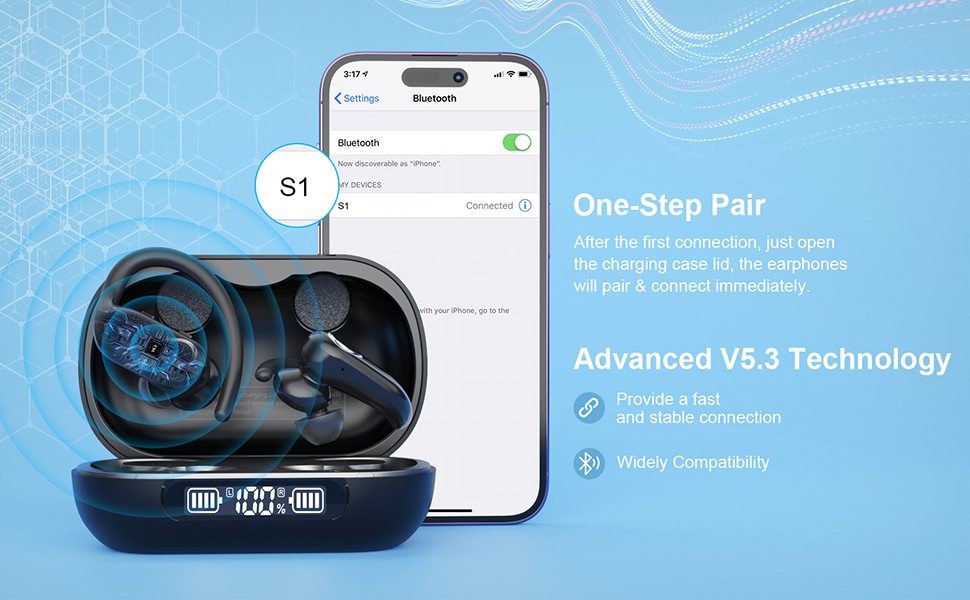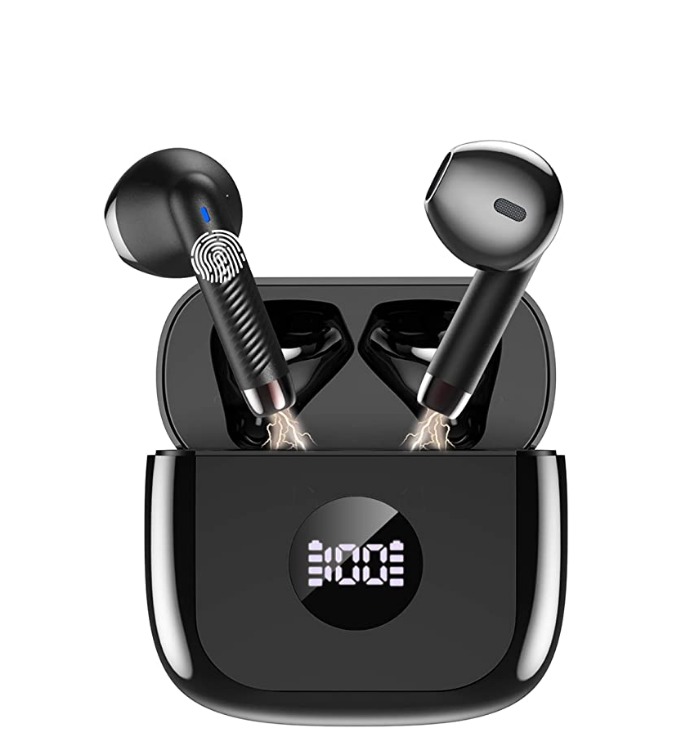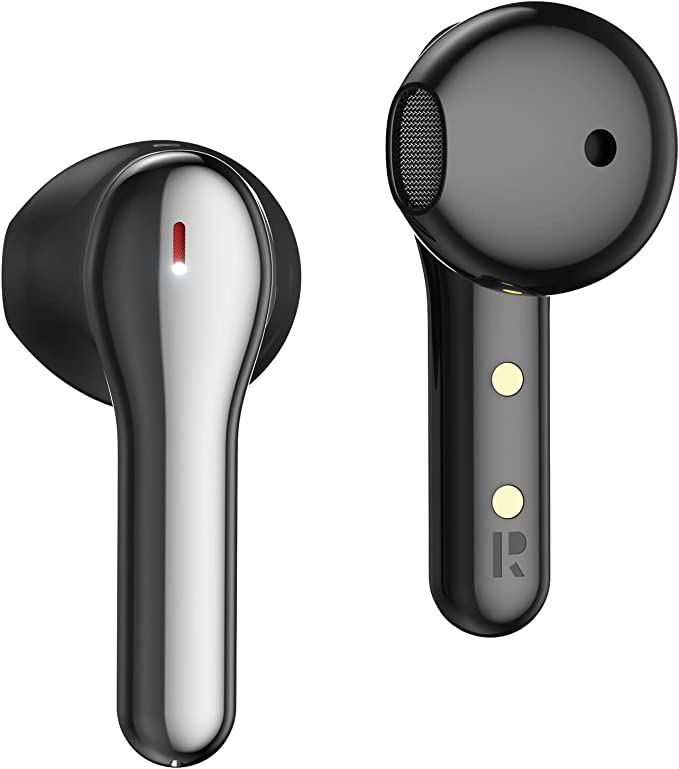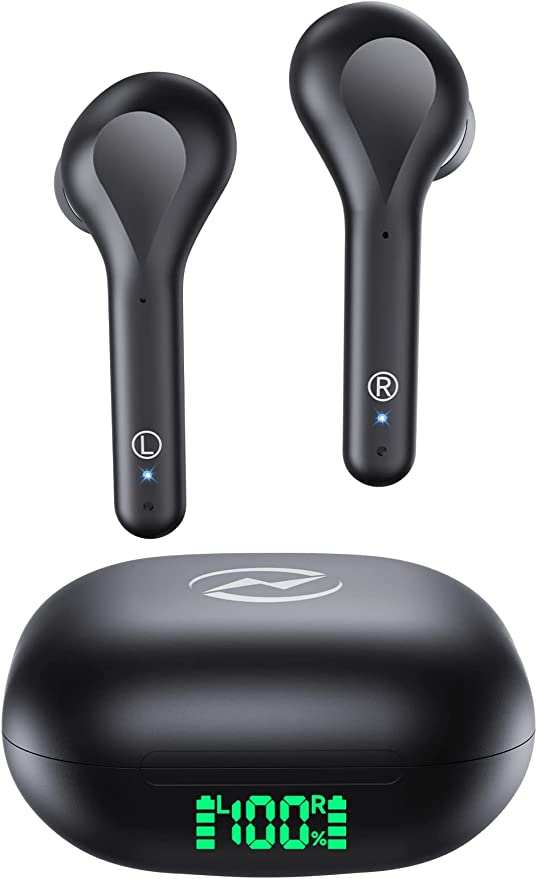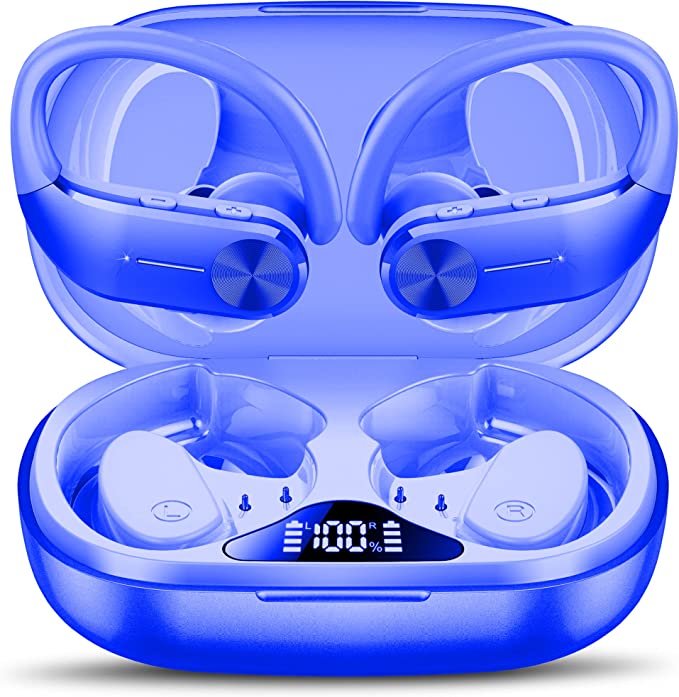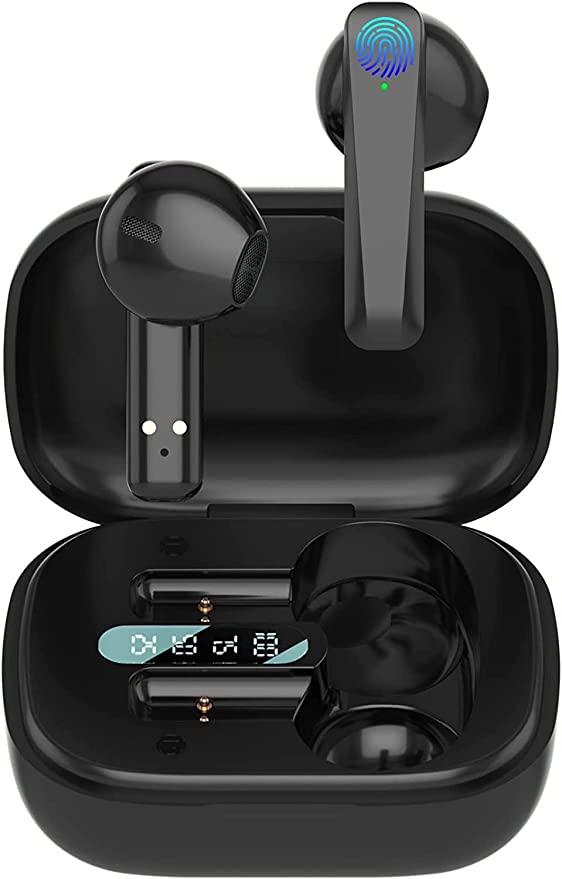HAPPYAUDIO S1 Wireless Earbuds: Unveiling the Science of All-Day Audio and Workout Freedom
Update on May 19, 2025, 5:34 p.m.
It is truly a marvel of our modern age to carry entire orchestras in our pockets, to have the voices of mentors and storytellers accompany us on a morning run, all without a single wire to tether us to a device. This quest for sonic freedom, for audio that is not just heard but felt and seamlessly integrated into the rhythm of our lives, has driven a quiet revolution in personal technology. Today, we’ll journey into the heart of this revolution, using the HAPPYAUDIO S1 wireless earbuds not merely as a subject of review, but as a fascinating lens through which to explore the elegant science and thoughtful engineering packed into these compact companions. Imagine me, Dr. Eleanor Vance, as your guide on this exploration, eager to unravel the intricacies of how these little marvels come to life.

The Invisible Dance: Decoding Wireless Fidelity with Bluetooth 5.0 and TWS
Our first foray into the S1’s capabilities takes us into the realm of the unseen: the wireless signals that form the lifeblood of its audio delivery. At its core lies Bluetooth 5.0. Now, version numbers can often seem like arcane jargon, but in the world of Bluetooth, each iteration represents a significant leap. Think of early Bluetooth versions as a narrow, winding country lane, capable of carrying only so much traffic at a leisurely pace. Bluetooth 5.0, by contrast, is a multi-lane expressway. It offers substantially increased data transmission speeds (up to 2 Mbps), a more extensive range, and, critically for battery-reliant devices like earbuds, significantly improved power efficiency.
But how does this “magic” happen? Bluetooth technology, named rather charmingly after the 10th-century Danish king Harald “Bluetooth” Gormsson, famed for uniting Danish tribes, similarly unites our devices. It operates in the 2.4 GHz ISM (Industrial, Scientific, and Medical) radio band, employing a clever technique called frequency-hopping spread spectrum. This means it rapidly switches frequencies (up to 1600 times per second across 79 channels!) to avoid interference and maintain a robust connection. For you, the listener, this translates to a more stable link to your smartphone, fewer frustrating audio dropouts whether your phone is in your pocket or across the room, and a longer period before your S1 earbuds whisper that dreaded low-battery warning. This enhanced stability and efficiency in Bluetooth 5.0 isn’t just about convenience; it’s about enabling a more reliable and immersive audio experience, crucial for everything from critical business calls to losing yourself in a cinematic soundscape.
To manage the actual audio data zipping through this Bluetooth expressway, the S1 employs the SBC (Subband Codec). A codec is essentially an electronic Crichton, a meticulous translator, compressing digital audio at the source (your phone) and decompressing it at the destination (your earbuds). SBC is the universal, baseline codec for Bluetooth audio, the lingua franca that ensures broad compatibility across myriad devices. While audiophiles might seek out more specialized codecs like aptX or AAC for potentially higher fidelity (these often require licensing and support from both the source and sink devices), a well-implemented SBC, as aimed for in the S1’s “professionally-tuned” sound, provides a perfectly enjoyable and reliable listening experience for daily music, podcasts, and audiobooks. It’s the dependable workhorse of Bluetooth audio.
Then there’s the marvel of True Wireless Stereo (TWS). This technology is what truly cuts that final cord, liberating not just the connection to your phone, but also the link between the earbuds themselves. The journey to TWS was an interesting one; early “wireless” stereo headphones still had a wire connecting the left and right earpieces. The engineering challenge was to enable two tiny, independent devices to receive separate left and right audio channels from a single source and play them back in perfect synchronization, with minimal latency. Imagine two trapeze artists performing a perfectly synchronized routine, each cued independently yet moving in flawless harmony – that’s TWS. Each S1 earbud can establish its own connection, or one acts as a primary receiver that then relays to the secondary. This architecture allows for remarkable flexibility. The HAPPYAUDIO S1 highlights this with its Mono and Twin Modes. Need to stay acutely aware of your surroundings while cycling or walking down a busy street? Pop in a single earbud (Mono Mode), your personal, discreet soundtrack that keeps one ear open to the world. Ready for deep immersion in your favorite album or an intense workout session? Use both (Twin Mode) for a full stereo soundscape that envelops you. This adaptability is a cornerstone of modern wireless audio convenience, allowing your audio to truly adapt to your life, moment by moment.
Forged for Endurance: The Art of Ergonomics and Resilience
An audio experience, no matter how pristine, falters if the delivery mechanism – the earbud itself – is uncomfortable or ill-suited to an active life. This brings us to the crucial aspects of ergonomic design and physical resilience, areas where the HAPPYAUDIO S1 invests considerable thought, aiming to become an almost imperceptible extension of the listener.
The most visually striking feature in this regard is the ergonomic ear-hook design. Why are ear hooks so important, especially for sports earbuds? The human ear is a wonderfully unique landscape, a complex terrain of cartilage and curves, varying significantly from person to person. A simple in-ear bud might suffice for sedentary listening, but introduce vigorous movement – the rhythmic impact of running, the explosive energy of a gym workout, even just the bustle of a hurried commute – and the risk of an earbud dislodging becomes a constant distraction, or worse, leads to a lost (and often lamented) earbud. The S1’s ear hooks, crafted from a “soft and durable flexible material,” aim to solve this by gently yet firmly conforming to the superior aspect of the auricle (the outer ear). Think of it as a bespoke, tailored embrace for your ear, ensuring the earbuds stay precisely where they belong, no matter the intensity of your activity. This secure fit isn’t just about preventing them from falling out; it’s also critical for maintaining a consistent acoustic seal with the ear canal via the silicone eartips (provided in three sizes: S, M, L). This seal is paramount for delivering the full spectrum of sound, especially bass frequencies which rely on that enclosed air volume, and forms the basis of passive noise isolation – your personal, quiet bubble in a noisy world, allowing the music to take center stage.
Beyond physical stability, there’s the ever-present challenge of environmental hazards, primarily moisture. Whether it’s the inevitable perspiration during a strenuous workout, an unexpected rain shower during your commute, or even an accidental splash, electronics and water have traditionally been sworn enemies, leading to short circuits and silent frustration. The HAPPYAUDIO S1 confronts this with an IPX7 water-resistant rating. The “IP” stands for Ingress Protection, an international standard (IEC 60529) that classifies and rates the degree of protection provided by mechanical casings and electrical enclosures against intrusion, dust, accidental contact, and water. The ‘X’ in IPX7 simply means it hasn’t been specifically rated for dust ingress (though a design that resists water often inherently offers some dust protection), while the ‘7’ is a significant indicator of water resilience. Scientifically, IPX7 signifies that the S1 earbuds can withstand submersion in up to 1 meter of fresh water for approximately 30 minutes. How is such robust protection achieved in such a small and complex device? It’s a feat of meticulous engineering, typically involving precisely designed casings with minimal openings, the use of waterproof seals or gaskets made from materials like silicone around any critical joints or entry points (like microphone ports or charging contacts when exposed), and sometimes even specialized hydrophobic nano-coatings applied to the internal circuitry that actively repel water molecules. For the S1 user, this translates into a profound peace of mind. You can push your limits during exercise, brave the elements, or simply not worry about everyday mishaps, knowing your audio companions are built to endure. It’s like having a miniature, wearable submarine for your sound, ready to accompany you on nearly any adventure.

The Soul of the Sound: Inside the 12mm Dynamic Drivers
Now, let’s delve into the very heart of the audio experience, the alchemical process by which electrical signals are transformed into the rich tapestry of sound that moves us: the 12mm dynamic drivers nestled within the HAPPYAUDIO S1 earbuds. To truly appreciate their role, a quick trip into sound history is illuminating. The invention of the moving-coil loudspeaker in the early 20th century (building on earlier telephonic principles) was a watershed moment, laying the foundation for much of the audio technology we cherish today, from colossal concert speakers to these tiny in-ear powerhouses.
At its core, a dynamic driver is an elegant transducer – a device that converts one form of energy into another with remarkable fidelity. In this case, it transforms electrical audio signals, carrying the complex waveforms of music or voice, into the mechanical vibrations that our ears perceive as sound. Imagine a miniature, highly sophisticated drum. The S1’s 12mm driver features a diaphragm (analogous to the drum skin, often made from lightweight, rigid materials like PET or composite polymers), a voice coil (a finely wound coil of wire, typically copper or copper-clad aluminum) attached to it, and a powerful permanent magnet (often neodymium, prized for its strong magnetic field in a small size). When the electrical audio signal from your device flows through the voice coil, it creates a fluctuating magnetic field around the coil. This induced field interacts with the static field of the permanent magnet, causing the voice coil—and thus the attached diaphragm—to vibrate rapidly back and forth, mirroring the waveform of the original audio signal. These precise vibrations push and pull the air in front of the diaphragm, creating sound waves – compressions and rarefactions – that travel through the ear canal to your eardrum, which then translates these vibrations into neural impulses our brain interprets as music, speech, or ambient sound.
Why does the “12mm” size designation matter, particularly in the compact world of earbuds? Generally, a larger diaphragm surface area can move a greater volume of air with each vibration. This often translates, especially in well-engineered designs, to a better potential for reproducing lower frequencies – the satisfying thump of a bass drum, the deep rumble of a synthesized bassline, or the rich resonance of a cello. It also can contribute to a sense of “fullness” or “body” in the sound. The S1 product information states these drivers are “professionally-tuned.” This “tuning” is where art meets science. It involves a multitude of factors beyond just driver size: the acoustic properties of the earbud enclosure, the material and geometry of the diaphragm, the damping applied to control unwanted resonances, and electronic equalization. The goal of such tuning is to create a balanced and pleasing sound signature – perhaps the “silky treble, smooth mid and punchy bass” described – that makes various genres of music, as well as spoken word content like podcasts and audiobooks, sound clear, engaging, and “immersive.” The 12mm driver in the S1 provides a robust electromechanical canvas upon which this sonic artistry is performed.

The Unseen Marathoner: Powering Days of Audio with 56 Hours of Playtime
In our increasingly untethered digital lives, battery life often feels like the Achilles’ heel of our most beloved portable electronics. The most feature-rich, best-sounding wireless earbuds are rendered inert and frustrating if they can’t last through your day, your workout, or your long-haul journey. The HAPPYAUDIO S1 addresses this critical concern head-on, boasting an impressive total playtime of up to 56 hours, a figure that promises to significantly alleviate battery anxiety for even the most ardent audio consumers.
This remarkable stamina is not the result of a single, monolithic power source, but rather a two-part harmony: the individual power reserves within the earbuds themselves and the much larger battery housed within their portable charging case. According to the product details, the S1 earbuds, when fully charged, can offer between 8 to 11 hours of continuous playtime. This considerable duration for such small devices is a testament to the ever-improving energy efficiency of modern Lithium-ion (Li-ion) battery technology packed into their tiny frames, coupled with the power-saving characteristics inherent in the Bluetooth 5.0 standard and the efficiency of the onboard chipset that manages power distribution. Li-ion batteries have become the ubiquitous champions of portable electronics due to their high energy density (meaning they can store a lot of power in a relatively small and light package), their ability to be recharged hundreds of times with minimal memory effect, and their relatively slow self-discharge rate when not in use.
When the earbuds’ own power reserves eventually dwindle after many hours of use, the charging case steps in. This compact case isn’t just a convenient place to store and protect your earbuds; it’s a portable power bank, itself containing a larger Li-ion battery. It’s designed to recharge the S1 earbuds multiple times over when you’re on the go, thereby achieving that impressive cumulative 56-hour figure. Imagine the earbuds as sprinters, capable of impressive bursts of activity for several hours, and the charging case as their dedicated support vehicle and mobile refueling station, always ready with a fresh infusion of energy to get them back in the race. One user review aptly captured this benefit: “They stay charged for hours. I have worked outside for six hours and never run out of juice.” This kind of longevity means you could potentially go for an entire week or more of typical daily use – encompassing commutes, several workouts, numerous calls, and evening relaxation – without needing to find a wall outlet for the case itself.
And when it’s finally time to recharge the case that recharges the earbuds, the inclusion of a USB-C port is a welcome nod to modern convenience and standardization. USB-C is rapidly becoming the universal standard for charging and data transfer across a vast array of devices, from smartphones and tablets to laptops and, yes, earbud charging cases. It’s prized for its robust, reversible connector (no more frustrating fumbling to plug it in correctly in the dark) and its inherent support for faster charging speeds when paired with a compatible charger. The S1’s case can be fully replenished in approximately 2.5 hours, ensuring that your entire audio ecosystem is quickly ready for its next long run, minimizing downtime and maximizing your listening pleasure.

A Gentle Command: The Nuance of Smart Touch Control
Interacting with our increasingly sophisticated miniature audio companions needs to be as intuitive and effortless as the listening experience they provide. The days of fumbling for tiny, hard-to-press physical buttons that often resulted in uncomfortably jamming an earbud further into your ear canal are, thankfully, receding. The HAPPYAUDIO S1 embraces the more elegant and often more ergonomic solution of Smart Touch Control.
This technology, which feels almost magical in its responsiveness, typically relies on capacitive sensing. Beneath the smooth outer surface of each S1 earbud lies a sensor that creates a minute, stable electrostatic field. When your fingertip, which is electrically conductive, comes into proximity or makes contact with this surface, it disrupts this field, causing a change in capacitance. The earbud’s internal microcontroller detects this change and interprets it as a specific command based on the nature of the touch – a single tap, a double tap, a triple tap, or a sustained hold. It’s akin to your finger speaking a silent, precise language with the device. With a series of these simple gestures – the product description mentions a triple-touch on either earbud to activate your smartphone’s native voice assistant like Siri or Google Assistant, or other taps to play or pause music, skip to the previous or next track, potentially adjust volume (as “turn up or down” is listed), or answer/end/reject calls – you can command a wide range of functions without needing to reach for your phone.
The primary advantage of touch controls over traditional physical buttons on such small devices is the minimal pressure required for actuation. This makes for a significantly more comfortable user experience, as you’re not pushing the earbud against your ear. As the product description aptly notes, this design “can minimize the pressure on your ears when you touch the panel for various functions.” While one user in the provided information resourcefully mentioned that the tap commands “could be a little less complicated,” they also thoughtfully acknowledged that “Once you get the hang of them, it’s not that difficult to manage.” This highlights a common aspect of many touch interfaces: there’s often a brief learning curve, a period of familiarization required to master the specific gesture vocabulary unique to that device. However, once that muscle memory is established, the convenience and subtlety of touch control often make it a preferred method of interaction. It’s about transforming complex operations into a series of gentle, almost subconscious, nudges, keeping you connected and in control without breaking your stride or your focus.

The Harmonious Blend: Technology Serving Experience
As we’ve journeyed through the various facets of the HAPPYAUDIO S1, from the invisible dance of Bluetooth waves meticulously weaving through the air to the tactile response of its touch controls awaiting your gentle command, a clear and compelling picture emerges. This device, like many of its contemporaries, is not merely a haphazard collection of disparate features; it’s a carefully orchestrated symphony of individual technologies, each playing its part, all designed to serve a singular, overarching purpose: to enhance the human experience of sound, freedom, and seamless interaction with our digital world.
The S1 stands as a microcosm of the broader, relentless trends in personal audio – the unceasing pursuit of better wireless fidelity for untangled listening, longer-lasting power to accompany us through our busiest days and longest journeys, greater resilience against the unpredictable elements of an active life, a more comfortable and secure physical fit that makes the technology feel almost like an extension of ourselves, and more intuitive, effortless control that keeps us in command without demanding undue attention. Each technological choice embedded within the S1, be it the strategic adoption of Bluetooth 5.0 for its robust efficiency and extended reach, the reassuring IPX7 rating that offers all-weather confidence, the selection of 12mm dynamic drivers tuned to deliver a rich and engaging sonic palette, or the ergonomic ingenuity of the ear hooks that promise stability without sacrificing comfort, contributes to a holistic experience that aims to be both profoundly empowering and delightfully unobtrusive.
The quest for the perfect personal audio device is, in many ways, an ongoing human endeavor, a continuous refinement of how we choose to integrate sound, information, and communication into the very fabric of our lives. Devices like the HAPPYAUDIO S1, born from a confluence of scientific understanding, engineering prowess, and a keen sensitivity to user needs, remind us that even the smallest and most commonplace gadgets can embody significant scientific principles and considerable artistry. By understanding a little more about the “how” and the “why” behind their often-astonishing functionality, we not only become more informed and discerning consumers but also gain a deeper, more resonant appreciation for the silent, intricate dance of technology that accompanies us, note by note, through our increasingly connected, sonically rich world.


